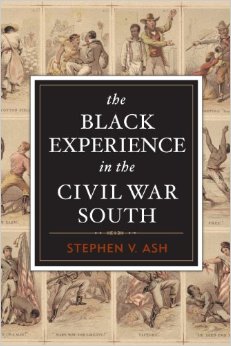The Black Experience in the Civil War South by Stephen V. Ash. Potomac Books, 2013. Paper, ISBN: 1612346294. $17.95.
 Stephen V. Ash’s The Black Experience in the Civil War South is a terrific introduction for those who are unfamiliar with the varied experiences of African Americans during the Civil War. The 2010 hardcover edition was originally a part of the Reflections on the Civil War Era series from Praeger, edited by John David Smith. The Black Experience fits well into the series, which aims to provide “concise, informed, readable syntheses” of the nation’s greatest conflict. Although little will strike scholars as new, the book is an excellent resource for undergraduate courses that cover Civil War, African American, or southern history.
Stephen V. Ash’s The Black Experience in the Civil War South is a terrific introduction for those who are unfamiliar with the varied experiences of African Americans during the Civil War. The 2010 hardcover edition was originally a part of the Reflections on the Civil War Era series from Praeger, edited by John David Smith. The Black Experience fits well into the series, which aims to provide “concise, informed, readable syntheses” of the nation’s greatest conflict. Although little will strike scholars as new, the book is an excellent resource for undergraduate courses that cover Civil War, African American, or southern history.
Ash provides a brief but comprehensive look at the southern black experience during the war years. He touches on those who were free and those who were enslaved; African Americans in the Confederacy and in the Border States; slaves and freemen in agricultural areas and in the cities; as well as the lives of men, women, and children. As Ash explains, he focuses on “the black people who lived in the Southern states during the war…what they did, what was done to them, and what they thought about their experience” (xi). The book includes five chapters that tackle various aspects of African American life in wartime, along with a short epilogue that hints at the challenges of freedom. Ash’s first chapter, “Freedom Delayed,” is perhaps the most important of the book. This chapter catalogues the experiences of those who spent most of the war in the depths of slavery. As he explains, even after the Union began actively seeking freedom for slaves following the Emancipation Proclamation, the “revolutionary transformation of Union war aims had no direct impact on most slaves until the war was over” (5). Focusing on those who did not gain freedom is particularly useful for teaching undergraduates, who are unlikely to know the limitations the war had in producing emancipation.
The next two chapters focus on the experience of African Americans engaged in agricultural labor and those in urban areas, describing the ways in which free and enslaved blacks worked to better their lives amid wartime challenges. “Life and Labor on the Land” touches on the changes that rural slaves experienced in their daily lives as a result of the Confederate war effort. With most white males fighting for the Confederate cause, black field hands often worked harder, focused more on food production, and were hired out to help the war effort. Despite these wartime adjustments, Ash explains, “the war brought no fundamental change in their relations with whites” (37). While a majority of African Americans lived on farms during the antebellum period, the war brought a greater demand for non-agricultural services. As Ash describes in his third chapter, “Beyond the Plantation,” such services ranged from acting as body servants for Confederate soldiers to producing arms and ammunition or serving on riverboats, canals, and railroads. Confederate and state governments often “impressed” these slaves, rather than hiring them out from willing slaveholders.
Ash’s fourth chapter, “Gaining Freedom,” explains how the change in Union policy toward African Americans as the war progressed both reflected and influenced the African American experience in the South. Here, Ash draws on the rich historical literature on self-emancipation to point out the ways in which slaves forced the issue of freedom by running to Union lines. Yet Ash cautions that both the slaves’ “thirst for freedom” and the “presence of Union armies” were critical to emancipation; “neither alone could have made emancipation an achievable aim; both were essential” (62). In a final chapter, “Experiencing Freedom,” Ash investigates the mechanisms by which slaves became free in the final years of the war, touching on contraband camps, Sherman’s Special Field Orders No. 15, and black soldiers.
There is much to admire about this book as a teaching tool. Students will appreciate the author’s matter-of-fact style of writing. There is also an ease with which Ash sums up decades of historiography on the black experience in the Civil War era. Scholars will recognize work from Leon Litwack’s Been in the Storm So Long (1979) to the Freedom documentary collection. Ash catalogues some of these influences in a useful bibliographical essay at the end of the book.
Overall, The Black Experience in the Civil War South is a welcome addition to the rich literature of slavery and freedom during the war years. The paperback price (which is significantly lower than the cost-prohibitive hardcover version) will also make the book a favorite for teaching undergraduates about the nuanced nature of African American life during the Civil War.
Rachel A. Shelden is Assistant Professor of American History at Georgia College & State University. She is the author of Washington Brotherhood: Politics, Social Life, and the Coming of the Civil War.

